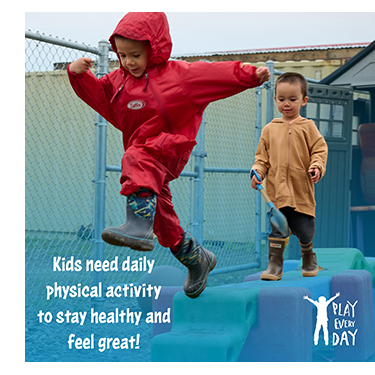Why is Physical Activity Important?
Physically active children tend to grow up to be physically active adults. A lifetime of physical activity can lead to better health.
Parents and caregivers can help children be more physically active by
making activity part of their daily life. Parents can spend time with their children by going outside, walking, sledding, playing catch, building a snowman, biking, swimming, playing at the park, and even doing chores together. Children learn from their parents the
joy and fun of physical activity by being active together.
Physical activity improves our health right away and years later too.

Activity can lead to immediate benefits, including improved blood pressure, blood sugar, attention, memory, and sleep that night. Being active can also reduce feelings of anxiety.
There are many
long-term health benefits of physical activity for children:
- Helps reduce the chances of developing obesity.
- Helps reduce the chances of developing chronic diseases that can last a lifetime, such as type 2 diabetes, heart disease, and certain cancers.
- Helps build and maintain healthy bones and muscles.
- Promotes mental and emotional well-being.
- Reduces feelings of depression and anxiety.
- Improves attention and memory, which may improve performance in school, including
- academic achievement and grades
- factors that influence academic achievement, such as focus in the classroom.
How much activity should kids get?
The
Physical Activity Guidelines for Americans recommend that children ages 3 through 5 be physically active for about 3 hours throughout the day for the best growth and development. Keep kids moving with a variety of light, moderate, and vigorous activities so they get some activity on and off throughout the day.
Activity for school-aged children ages 6- 17
Get out and play, 60 minutes every day. To feel great and maintain a healthy weight, the
Physical Activity Guidelines for Americans recommend children ages 6- 17 get at least 60 minutes of daily physical activity. Physical activity is anything that gets your heart pumping or makes you stronger.
Supporting active kids
Parents and caregivers can encourage many types of active play. Children benefit from structured activities, like planned games or kicking and tossing a ball. They also benefit from free play that lets them move as they want. Give children access to outdoor spaces that allow them to express themselves with more movement, louder voices, and messier play.
Limit the amount of time your kids are in front of screens when it’s not for schoolwork. Set daily or weekly time limits on smartphone and computer use, television watching and video gaming.
Read more about recommended daily limits.
Come up with fun ways for the whole family to play. It doesn’t matter what it looks like – an organized soccer match or a backyard game of tag. Finding ways to add a little more activity to every day can mean big health benefits for your children. Try one of these activities as a family.
Read more about the importance of play and activity

Webpage updated October 2024